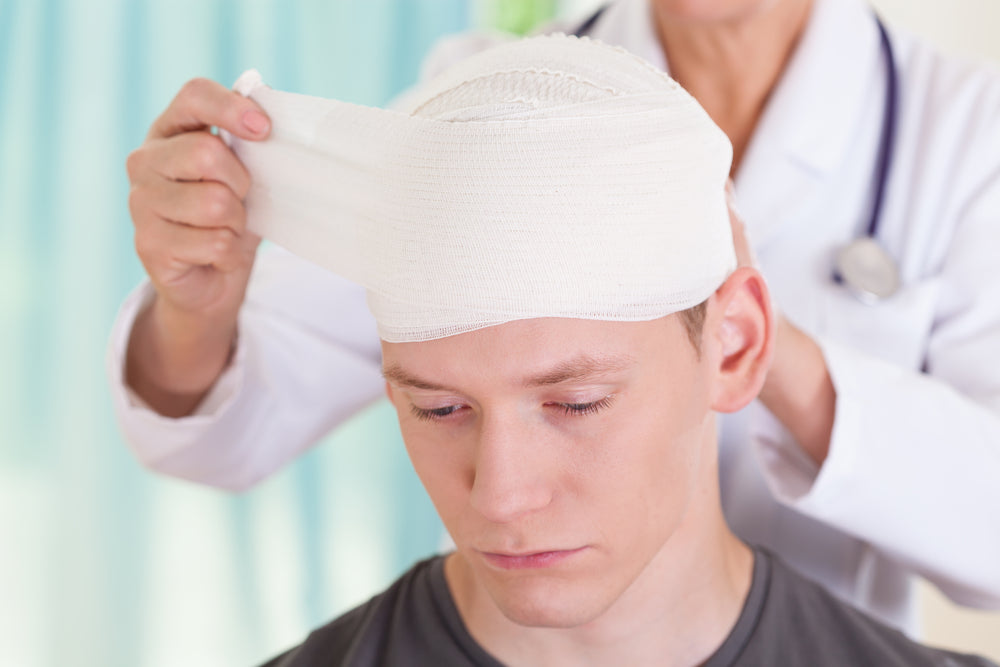In March of 2016, the NFL senior vice president of health safety policy admitted the connection between head trauma with football and Chronic Traumatic Encephalopathy (CTE). That is a fancy word for brain changes due to hits to the head!
Over 30% of football players have shown changes years later from injuries in the professional, college, or high school level. We think of boxers, and certainly Mohammed Ali as a prime example, of early Alzheimer’s Disease and early onset memory losses (dementia).
Ok, but what about our children?
The diagnosis of a concussion that causes clinical problems or even mild traumatic brain injury is difficult. Currently, those of us needing to make the diagnosis rely on patient symptoms and clinical judgment. Recently, focusing tests measuring the brain response to visual stimulus measured in milliseconds are being utilized comparing baseline data with data after a suspected injury. This is making it difficult to determine at the moment of injury when to stop play or when the patient is safe to return to full activity.
In 2010 it was the Purdue Neurotrauma Group that first documented significant changes in the brain from multiple hits, even without a concussion. They looked at hits over time, to even include soccer players heading the ball!
Their conclusion: Something is happening over time that is causing changes in the brain.
Years ago as a physician, it seemed that most doctors who treated a patient with a concussion would get a skull X-ray. No fracture made the physician feel any better. I didn't feel like this was important and refused to expose kids to needless X-Rays.
The reason I didn't recommend x-rays was because it didn't matter if the skull was cracked or not, that was no indication whether or not the brain had been shaken and a concussion had taken place. A cracked skull, it seems to me, is the dissipation of the force and is protective.
Now speed up our knowledge of concussions and counter-coup trauma (the even more violent shaking of the brain that happens on the opposite side of the trauma). The brain floats within the skull, and it is like shaking an egg violently. The egg is floating in its yolk for protection, but the brain has no such protection. So small head accelerations can cause problems, and the cells may rupture, some of the trillion neurons and connections become damaged, and the stretch and stress placed on them can be massive or small, messing up the myelin bonds and synapses (connection gaps between neurons). Over time researchers are now seeing changes occurring in the brain.
The flow of information within the brain is disrupted where damage occurs. The difficulty is finding it. For instance, when listening to someone we rely on two pathways to the frontal lobes which helps us with easy to hear and hard to hear sounds. Damage to one may happen but the other takes over, so we do not realize there has been damage. It is this potential for hidden damage that has caused us to not be worried in the past, but now with newer brain mapping and studies we know it is occurring.
Pediatrics Journal in October 2016 reported a study from the University of Washington’s “Department of Psychiatry and Behavioral Medicine” on postconcussive symptoms and care of the adolescent athlete. “Post-concussive and co-occurring psychological symptoms are not uncommon after sports-related concussions and are associated with functional impairment and increase in societal costs.”
Concussions may cause an increase in ADHD symptoms
They also reference the many articles showing how there is an increase in ADHD and mental health disorders after a child or adolescent suffers a concussion. One of my patients had 9 concussions playing hockey in the NFL, and there have been definite changes in his mental processing speed over time.
Wake Forest University in October 2016 also reported on their recent study on football players from ages 8-13 years of age. They did brain scans before on these kids before and after a year's worth of sports. The only catch was that during that time the child was not allowed to have had a diagnosed "concussion."
They found that just normal head banging in football caused brain changes! Wow! The medical community is not exactly sure what to make of these findings, but nevertheless, these changes exist!
This week, November 11, 2016, Western University’s Children’s Health Research Institute reported on a blood test that is very accurate in measuring a panel of metabolites (small molecules produced from the body’s metabolism) “in the blood to search for distinct patterns that indicate a concussion has occurred.”
This is a significant breakthrough and one I am sure we will be utilizing in the coming year. This definitely helps with diagnosis and we will have to evaluate if it can help with determining recovery time.
What can we do to protect our children and all those playing contact sports?
First, we need to educate each other and keep watching medical studies and comments from professionals dealing with the brain and concussions.
Make sure the coaches and officials are knowledgeable on the subject, and you as a parent need to understand that protection is the key!
UNC performed a landmark study several years ago with their football team which has led to little or no head contact during practice! This has significantly lessened the number of head impacts. Teaching proper tackling and targeting the opponents head. Soccer needs to consider the use of helmets and protection against head injury. Pitchers in baseball and batters are at the highest risk.
Secondly, we need to make sure parents, coaches, and officials are knowledgeable on the subject.
UNC performed a landmark study several years ago with their football team which has led to little or no head contact during practice! Instead, they taught proper tackling and targeting of the opponents head. This significantly lessens the number of head impacts. Soccer also needs to consider the use of helmets and protection against head injury. Baseball players are also at risk, especially those at bat.
These studies are showing that there are changes over time. Andy Farah, MD a noted UNC psychiatrist on head trauma, believes studies are showing that multiple head trauma is causing mental health problems and that the head trauma and ADHD go hand in hand.
Third, we need to protect, prevent, and care for head trauma.
High dose omega 3, such as found in the FastBraiin DHA, are showing a protective effect in the brain. The reasoning is not exactly clear, but it is thought to work on the structural health of the brain cell itself. The use of these high dose combinations is seeing a quicker recovery time in those who have had a concussion.
This is amazing and I would go so far as to say all athletes, regardless of the age, engaging in contact sports that may involve head trauma, should be on these supplements as a daily preventative. Working with a Ph.D. biochemist from Emory University I worked on a safe and pure form for my patients. I am now recommending FastBraiin DHA and PS to all my patients who play contact sports.
DHA, when taken alone, can have trouble getting into the brain. That's why we recommend taking DHA with Phosphatidylserine as well. PS (a basic structural component of cells and responsible for effective cell communication) helps the DHA actually get into the brain so it can perform its intended function. The DHA and PS work synergistically together.
An added benefit for my ADHD kids is that a study at the University of Pennsylvania in May 2016 showed how when these supplements are added in the diets of children with extreme aggression that the “problem behavior in the short term, especially its more impulsive, emotional form, is lessened.”
Now that is something to think about!
FastBraiin.com is focused on keeping you up to date with the latest in evidence-based care and studies to allow you to make informed decisions about your child’s mental, educational, and emotional development.




